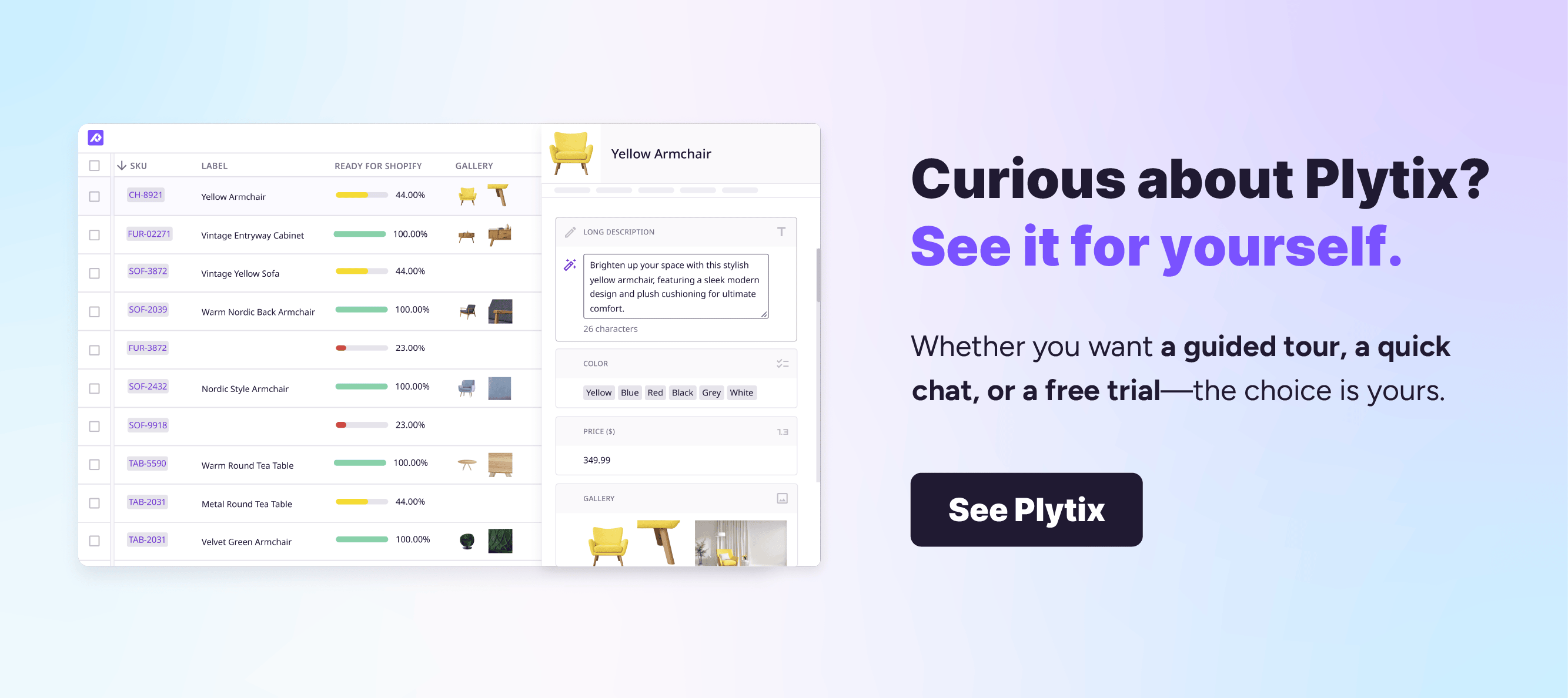Ever wonder how manufacturers, distributors, and retailers all stay aligned on product data? In many cases, it’s thanks to GS1.
If you work with product information, you’ve probably come across GS1-issued GTINs—those unique 14-digit product identifiers you often see in barcodes. But GS1 is about more than just labeling. It’s a global rulebook that sets the standard for how product data is identified, described, and shared.
In this guide, we’ll walk you through what GS1 standards are, why they matter, and how tools like PIM and GS1 connectors can make compliance a whole lot easier.
What is GS1?
GS1 (short for Global Standards 1) is a global not-for-profit organization that sets the rules for how businesses talk about products and product data. Their global standards cover how to identify products and describe and share product information.
While product identification and data sharing are GS1’s bread and butter, they’ve got fingers in plenty of other pies. Their standards also cover shipment labeling and tracking, counterfeit prevention, and electronic documents like purchase orders and invoices (anything supply chain related, basically).
The main building blocks GS1 uses to do this are:

GS1 operates through a network of 100+ local member organizations—like GS1 US, GS1 UK, and GS1 Germany—so when you register or need support, you’re working with a local team.
But what does all this mean in practice? Let’s break it down.
What does GS1 do?
They give every product a unique ID
GS1 issues Global Trade Item Numbers (GTINs). You can think of a GTIN as a unique fingerprint for each product and product variant.
Every product gets its own GTIN, which everyone (from manufacturers to distributors to retailers) can use to easily identify it and match it with the right product data.
GTINs are also baked into a lot of the codes you see every day, like UPCs (the barcodes scanned at checkout) and ISBNs (those numbers on the back of books). So when someone scans a product—whether it’s a candy bar or a novel—their system instantly knows what it is, who made it, and what to do with it.

They create a shared “product language”
GS1 standards are global standards for how to describe products. This includes rules for things like:
- How to describe size, weight, and color
- How to format data
- How to categorize and structure product information
With GS1 standards, everyone follows the same playbook, so a retailer in Canada and a distributor in Spain can talk about the same product without anything getting lost in translation.
They power a secure system to share product data
GS1 runs the Global Data Synchronization Network (GDSN)—a system that lets manufacturers and suppliers around the world share product data with retailers and marketplaces in real-time. This means that everyone always has the latest, most accurate information about a product.
In short, GS1 creates the rulebook for sharing product data globally. They make sure that everyone—manufacturers, distributors, and retailers—is on the same page when it comes to how they send and receive product information.
Why is GS1 important?
GS1’s standards keep the world’s supply chains running smoothly. Without international guidelines, allergen information could be mislabeled on food products, hospitals might receive the wrong medical devices, and you could never be sure what size jumpers you were going to end up with. There would be delays throughout the entire supply chain as a result.
Pretty serious stuff. But from an individual business’s perspective, the main reasons you need to meet GS1’s standards are to:
Get listed on major retailers and marketplaces
Planning to sell on Amazon, Walmart, or eBay? You must have official GTINs from GS1 and GS1-compliant product data to even list your items. And it's not just the big players—many smaller retailers expect the same.
If your product data isn’t GS1-compliant, you risk:
- Being blocked from listing your products
- Delays in launching with new retail partners
- Wasting time fixing rejected or mismatched data
Share accurate product information with your partners
Sharing product information is hard if what you’re calling a “30cm blue cushion,” your trading partners named a “30-inch navy pillow.”
GS1 standards fix this by giving each product variant a unique ID (a GTIN) to identify products and by setting clear rules for how to describe and format things like color, size, and material. That way, when you share information, no matter who’s receiving your data—or what system they’re using—they get exactly what you intended.
Stay compliant in sensitive industries
Hospitals, regulators, and food distributors rely on GTINs (plus location and shipping identifiers like GLNs and SSCCs, also issued by GS1) to track products across the supply chain and respond quickly when something goes wrong.
Take a medical device recall: if a batch of pacemakers has a defect, GTINs make it possible to see exactly which units were affected, what locations they were shipped to, and who received them. That traceability can save lives. It protects your consumers, your partners, and your brand.
Note: Consumers are becoming more interested in where their products come from and how they’re made. In fact, the EU is introducing a Digital Product Passport (DPP)—a digital record of a product’s performance, sustainability, and circularity. Just like GS1, it’s all about clearer, more reliable data. Learn more about it in our article about the Digital Product Passport.
GS1 standards compliance: What do you actually need to do?
As a business, you don’t need to memorize the GS1 rulebook—but you do need to tick the right boxes to keep your product data compliant so you can share it with retail partners and list it on major marketplaces.
Here’s what that looks like in practice:
1. Get GTINs for your products
You have two options when it comes to getting GTINs for your products:
- The GS1 Company Prefix: Great for companies managing lots of products. A prefix allows you to create GTINs for between 10 and 10,000 products, all with the same company prefix.
- Single GTIN: Best for businesses with a limited product range. Just license individual GTINs as you need them.
You license GTINs through your local GS1 organization. Want to find out more about how GTINs work and where to get one? Check out the GS1 US’s official guide.
2. Keep accurate and consistent product data
Once you have a GTIN for each product, you need to make sure you have all the product data—like descriptions, technical specifications, and assets—you need to meet GS1 standards, and that it’s actually linked to the right GTINs.
A PIM (that’s short for Product Information Management) is a great way to do this. It keeps all your product information in one place so you can organize and optimize it easily. When your internal data is accurate, formatting it to meet GS1’s standards becomes a whole lot easier.
Let’s take a look at how PIM helps you get your product data GS1-ready:
- Centralize all your product data and link it to a GTIN
Store product data like descriptions, dimensions, and assets in one place—and link each piece of data to the correct GTIN. - Structure your product content to meet GS1 standards
Follow formatting rules for attributes like color, size, and material. You can even use computed attributes to set automation rules, like applying naming conventions or units during export. - Track completeness at a glance
See what data is missing before it becomes a problem. Set up completeness attributes to make sure your product listings meet GS1 (or retailer-specific) requirements before anything gets published. - Push your GS1-compliant data to your sales channels
Skip the manual uploads. Use live feeds to automatically share formatted data with your retail partners, marketplaces, or sales channels.
In short? A PIM helps you organize, optimize, and distribute your product data at scale, making it easier to stay GS1-compliant.
Psst: Want to find out more about PIM? Check out everything you need to know about PIM.
3. Match your data to GS1’s standards
Once your product information is organized in a PIM, the next step is to format it to meet GS1 standards and share it with the GS1 network (aka the GDSN).
To do this, you’ve got two options:
-
You can format your data manually—GS1 provides industry-specific guidelines, but we recommend contacting your local GS1 organization for hands-on support.
-
You can automate the process with a GS1 connector, like Qmica, which formats your product data to match GS1 requirements, checks for issues, and gets it ready to publish.

With a GS1 connector, you can:
- Map your product data to GS1 standards
Have attributes like size, color, or packaging type? A GS1 connector helps adjust your product information into the exact format GS1 expects.
Tip: If you work in the electrical or electronic industry, you’ll want to use the Qmica Connector. It’ll help you make sure your data is ETIM-compliant (ETIM is a classification system that specifically focuses on the electrical and electronic industry). - Publish directly to the GDSN
Connect directly to GDSN, the GS1’s data-sharing network. Just hit publish, and your retail partners will be able to access your product information. - Stay updated when standards change
GS1 rules changed? GS1 connectors like Qmica will let you know and help you stay compliant.
In short, Plytix PIM helps you centralize and optimize your data. A GS1 connector (like the Qmica GS1 connector) helps you get it out the door—GS1-ready.

The takeaway
GS1 standards keep supply chains around the world speaking the same language. With unique identifiers like GTINs, standardized formatting, and real-time sharing via the GDSN, GS1 is essential if you want to list your products on major marketplaces, comply with regulations, or share data effectively with your retail partners.
While meeting GS1 standards might seem complicated, it doesn’t have to be—especially if you’re using the right tools. We recommend using a PIM to keep your product information organized and up-to-date, and a GS1 connector to automatically format it to meet GS1 standards.





